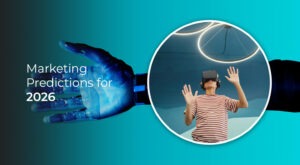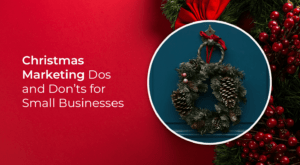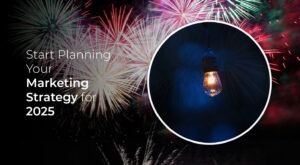It seems like everybody is on the internet today, in fact almost 4.54 billion people were active internet users as of January 2020. With the worldwide online population constantly increasing, this is the age of digital.
With the change in the way people consume information comes a change in the way companies market their products to potential customers.
100 years ago, advertisers took advantage of radio to get their products known.
50 years ago, print publications and TV advertising were on the rise.
But now with the surge of Google, social media and mobile apps, digital marketing is the way to go.
Click the links below to jump to each section:
- What is Digital Marketing?
- Search Marketing
- Social Media Marketing
- Content Marketing
- How do you Decide What you Need in Your Marketing Strategy?
- How do you Measure Your Marketing Success?
What Is Digital Marketing?

Digital marketing is an umbrella term for any marketing and engagement activities done via online media channels. Quite simply, it is the act of promoting your products and services online with the aim of increasing conversions, whether that conversion is a customer purchasing a product or a potential sales lead signing up to your newsletter.
You should see it as very similar to traditional offline marketing, the only difference is that you’re connecting with people online rather than in the ‘real world’.
This can be done in a number of ways, which we’re about to dive into below.
What are the Key Types of Digital Marketing?
Here’s a rundown of some of the most common digital marketing strategies businesses use to reach people online:
Search Marketing
Search marketing can be split into two sections: unpaid or organic, and paid. The term encompasses SEO (unpaid) and PPC (paid).
Both of these marketing tactics are done to gain traffic and visibility from search engines like Google and Bing which will then result in more people in your target audience seeing your website when browsing the internet and proceeding to buy from you rather than your competitors who appear below you in the search results.
Search Engine Optimisation
SEO (Search Engine Optimisation) is the practice of optimising a website to receive the best possible rankings in the search engines organically. This means when a user searches a query, your website will show up for the query it has been optimised for. For example, if a user searches “SEO Agency Hull”, you will see our website on the first page of the organic search results.
SEO is crucial for your business’s digital presence, as 93% of online experiences begin with a search engine. A strong SEO campaign will increase the amount and quality of traffic your website receives. It will attract potential customers who are genuinely interested in what you have to offer as you have optimised for what they are searching.
There are 3 main aspects of SEO:
- On-Page SEO – Optimising the elements of an individual webpage including optimising its content with relevant keywords, optimising title tags to show Google what the page is about, and ensuring the page has a good URL structure.
- Off-Page SEO – Actions taken outside of your own website to improve your rankings within the search engine results pages (SERPs). This includes building backlinks, social media marketing and guest blogging.
- Technical SEO – Optimising the technical side of your website to help both Google’s bots and your website users better navigate your website. This includes indexing pages, implementing a sitemap and improving your site loading speed.
PPC
PPC (Pay-Per-Click) is a type of marketing where advertisers can promote their business in the search results of a search engine and pay a fee every time one of their ads is clicked. PPC is a great way to direct relevant traffic towards your website instantly, as your ads will always show up at the top of the search results making them the first thing your potential customers see when searching the web.
Google Ads are the most common form of PPC and they can be broken down into three types of campaigns:
- Search Campaigns – These appear similar to a regular, organic search result, as a matter of fact 46% of people can’t tell the difference between an organic and paid search result.
- Display Campaigns – Display ads are shown to your target audience as images or GIFs, often in a banner style, on any websites the user is browsing even if the website isn’t related to your business. These ads are great for retargeting as they ‘follow’ the user around online, helping them remember your brand.
- Shopping Campaigns – These ads are shown on the Shopping tab of Google Search. This type of campaign is most suited to ecommerce businesses as it displays your products as an ad.
PPC is a great way to bring traffic to your website, increase brand awareness and boost online sales. Think of it as a Times Square billboard but digital – pay-per-click ads done well will grab people’s attention instantly and nudge them to interact with your brand.
Social Media Marketing
Social media marketing is using social media platforms such as Facebook to connect with your target audience/ customers to build brand awareness, drive traffic to your website and increase your sales.
There are two types of social media content. The first being organic social media posts, organic posts are free, and they reach your audience organically without any paid incentive.
The second type of social media content is paid social media marketing, this is when you purchase promotion for your posts, these types of posts are displayed exclusively to users within your target audience.
Why Do You Need It?
With 3.2 billion social media users worldwide in 2019, here are the top ways you can benefit from social media marketing:
- Brand Awareness – If people don’t know your business, they can’t become customers. Social media allows you to boost brand awareness by improving your visibility online.
- Generate Sales – With social media ads, you can promote ecommerce products to your potential customers and retarget those who have shown interest in your products but not yet made a purchase.
- Improve Customer Service – Through connecting with your followers in a human way, you can build strong relationships which equal happy customers.
Content Marketing
Content Marketing is a strategic approach focused on creating and distributing valuable, relevant and consistent content. The aim of content marketing is to attract and retain a clearly defined audience to drive customer action. Customers usually come to a website looking for information and content marketing is all about solving their problems.
Around 93% of B2B marketers use content marketing and there are many ways you can implement it into your marketing strategy including:
- Blog posts and pillar content
- Ebooks
- Video content
- Webinars
- Infographics
- Newsletters
Using the above content marketing methods will help drive valuable traffic to your website, position you as an authoritative figure in your industry, and explain your products/services to your potential customers.
How do you Decide What you Need in Your Marketing Strategy?
Digital marketing can work for any business in any industry, but a well carved out strategy is what will really set you apart from the rest. The types of marketing you employ depends on the goals you want to achieve, your target audience, and your audience’s needs at different stages of the buying journey.
You should start by thinking about your end goal. Is it to increase brand awareness? Promote your newly-opened ecommerce store? Increase newsletter signups? Improve your customer service?
Different platforms work best for different marketing goals, for example social media marketing will work wonders for brand awareness but it may not be as effective as PPC for driving ecommerce sales as people tend to online shop on Google rather than social media.
Who you’re targeting is another important factor. Think about your ideal buyer persona and consider their age range, gender, location, interests and whether they’re B2B or B2C. Different demographics will interact with digital platforms differently, so keep this in mind particularly with social media marketing.
The way you market your audience also depends on how far along the marketing funnel they are. There are three main stages to this funnel:
Awareness
Potential customers are first learning about your brand and what it has to offer, but they are not yet a warm lead. Here, we would advise strengthening your SEO with blog posts, sharing infographics, and being human on social media with short videos and updates.
Consideration
At this stage, the potential customer should be seen as a warm lead, capture their interest with targeted ebooks, offers, ads and monthly newsletters to offer more information about your products and services.
Decision
When the buyer is making a decision to purchase, think about what makes them choose you over competing brands. Here you should remind potential customers of why they should use your product and how it will offer a solution to their problem with retargeting ads on Google or social media. We’d also suggest continuing to build out your content and work on SEO to help position your brand in the long run.
How do you Measure your Marketing Success?
It’s easy to fall into the trap of focusing solely on your marketing efforts but not putting time into measuring and reporting your results. If you can’t measure your success then how do you know your spending your hard-earned budget effectively? That’s why we send out tailored monthly reports to our clients to track results from Social Media Marketing, SEO, PPC, Newsletters, Google My Business and GRO Insights. Alongside these reports, our specialists monitor all campaigns daily to make sure they’re yielding the best results – we never settle for less.

With so many tools out there like Google Analytics and built-in insights features on platforms like Google AdWords and Facebook, you can easily track things like:
- Users
- Sessions
- Goal Completions
- CPC (cost per click)
- CTR (click through rate)
- Leads
- Conversions
So with all this in mind, are you ready to create a killer marketing strategy?
Ends.



